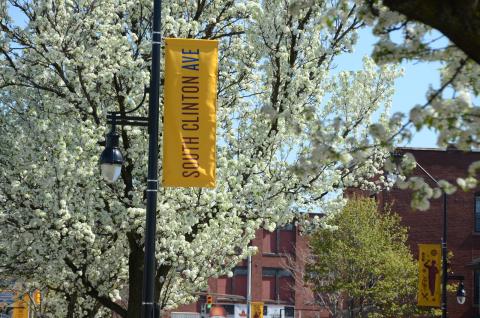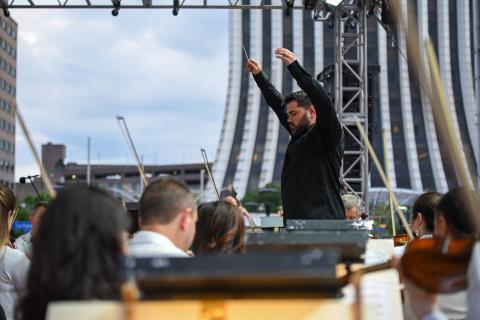West River Wall Improvement - Phase I (Corn Hill Segment)
About the Project
The West River Wall is located along the west side of the Genesee River adjacent to Exchange Boulevard, directly east of the Corn Hill Neighborhood within the Center City Downtown District. The site extends from Corn Hill Landing south to the Ford Street Bridge in the City of Rochester. The length of the wall is approximately 2,200 feet. This section of wall was previously characterized by a crumbing concrete flood control wall, overgrown vegetation, trail deficiencies and lack of public access to the River and its view sheds.
The City obtained professional consulting engineering services to guide the planning and design of the reconstruction of the western wall of the Genesee River as well as the river corridor itself. Critical safety inspections were needed to ensure that the wall could handle an emergency flood situation.
Improvements considered included a new alignment for the Genesee River way Trail (a National Recreation Trail), waterfront pedestrian promenade, lighting, landscaping, fencing, and other pedestrian amenities. Opportunities for scenic overlooks, docks, and public art were be explored.
This project is part of the ROC The Riverway initiative, a plan to revitalize the severely underutilized Genesee Riverfront in the core of Rochester, New York and to initiate greater interaction of the citizens and the waterfront. The improvements to the West River Wall work toward achieving this overall vision for Rochester and reestablishing our identity as a vibrant waterfront community.
Project Description
In collaboration with the New York State Canal Corporation (NYSCC), the New York State Department of State, the Corn Hill Neighborhood and the Plymouth Exchange Neighborhood (PLEX), the City of Rochester led the project on the west side of the Genesee River to rebuild the west river wall, enhance the area along the river and provide connections to the waterfront area for the adjacent community areas. The Corn Hill Segment 1 project site is located in Downtown Rochester along the west bank of the Genesee River occupying a 4+/- acre site that extends approximately 2,200 LF in the north south direction from Ford Street to the Corn Hill Landing Development and approximately 80 LF in the east-west direction from the Genesee River to Exchange St.
The original river wall, constructed in 1918 as part of the Barge Canal System, functioned to protect the surrounding area from flooding. Prior to implementing the project, the wall was found to be generally in poor condition and displaying signs of significant deterioration. In 2008, in producing a seamless county-wide map for Monroe County, FEMA showed that the river wall was no longer providing flood protection due to the condition of the wall, resulting in newly mapped floodplain areas in Corn Hill.
The State of New York under the jurisdiction of the NYSCC currently owns the wall and immediate river frontage. Heavy vegetation and trees were present along the back side of the wall and served as a physical and visual barrier between the adjacent Corn Hill Neighborhood and the Genesee River. To the west of the river and wall, Exchange Boulevard further separates the neighborhood from the river and from the Genesee River way Trail, as there were limited safe locations for pedestrians to cross the street.
Utilizing a combination of construction funding from the City and NYSCC, and RG&E the project advanced the City’s Local Waterfront Revitalization Program (LWRP) and built upon preliminary planning and design funded by a previous NYSDOS EPF LWRP award.
A detailed hydrologic and hydraulic analysis of the Genesee River was conducted as part of the project in order to properly determine required flood protection elevations. Within the project limits, the river wall has been reconstructed in a manner aligned with NYSCC, USACE and FEMA accreditation standards to provide a contiguous line of flood protection along the project for the adjacent community while also improving visual and physical connection to the river and creating a new linear park. This has been accomplished through the construction of three distinct types of treatments along the project site.
- Plaza and North & South Tie-In Areas: At the riverward edge of new gathering plaza across from the Fitzhugh Place/Exchange Boulevard intersection, and at the extreme north and south ends of the project (where the river wall passes under the Ford St. Bridge to the south and abuts the previously reconstructed wall at Corn Hill landing to the north), the river wall has been reconstructed/refaced down to approximately 2 ft. below the normal pool elevation. Additionally, rock anchors have been installed through the wall to improve the wall’s stability. The plaza features aesthetic hardscaping, stairs, railings, planting beds and provides overlook viewing of the river and Downtown skyline and gathering space opportunities during special events on the waterfront. Situated above the adjacent Exchange Boulevard elevation, the plaza features stairs and ADA walkways down to the roadway configured in a manner to provide a “grand” entrance to the newly formed park.
- Berm/Lawn Areas: Over a length of approximately 400 ft. on either side of the new plaza, the river wall has been cut down and refaced from approximately 2 ft. above the normal pool elevation to approximately 2 ft. below the normal pool elevation. A trapezoidal earthen berm, setback approximately 40 feet behind the wall, has been constructed to provide the required line of flood protection in these areas. Short runs of faced sheet pile retaining walls tie each end of the berm areas into the full height river wall segments at the plaza and north/south tie-ins. The berms slope gently towards the river along with a flat area immediately adjacent to the wall. This configuration greatly improves visual sight lines of the river and provide for gathering/recreational lawn areas closer to the water.
- Naturalized Shoreline Area: At the southern end of the project, over a reach of approximately 480 ft., the river wallhas been cut down approximately 2 ft. below the Genesee River’s normal pool elevation and the land behind the wall graded on a 1:3 to 1:5 slope tying up into existing ground thus allowing the river’s water edge to “enter” into the project site passing behind the plane of the existing wall. This sloped area has been treated with a combination of stepped cut stone blocks native to the area along with cobbles/rip-rap and planted with water-tolerant vegetation to create a natural shoreline effect and provide a unique opportunity to access the river’s edge along a stretch that was walled off on both side of the river within the Downtown corridor. All areas in the lawn and natural shoreline area that are riverward of the line of flood protection will be designed to resist storm flows. Throughout the length of the project, a 12-foot wide pedestrian/bicycle trail has been constructed, replacing the existing trail and providing better visual and physical access to the river and connections to the existing trail/promenade network at the north and south ends of the project.
Project Objectives
- Improve/restore flood protection
- Provide visual and physical access to the Genesee River
- Economic and neighborhood revitalization
- Create connections to the neighborhoods
- Enhance connections to the popular Genesee Riverway Trail
Project Team
The design consultant team of Bergmann Associates with “W. Architecture & Landscape Architecture, LLC”, “Popli Design Group”, “Marques & Associates, P.C.”, “Lu Engineers”, and “Nature’s Way” were selected through the City’s Request for proposal (RFP) Process to provide engineering, planning, and design services for the project.
Project Schedule
- Fall/Winter 2017 - Design Consultant Procurement
- Spring 2018 - Site Reconnaissance
- April 2018 - Community Advisory Meeting
- November 2018 - Public Meeting #1
- December 2018 - Community Advisory Meeting
- Summer 2018/Spring 2019 - Scooping and Preliminary Design
- July 2019 - Public Meeting #2
- Summer 2020 - Begin Construction
- Summer 2022 - Construction Completion
Project Documents
- 2015 Master Plan: January, 2015
- Public Information Meeting #1: November, 11, 2018
- Public Information Meeting #2: July, 17, 2019
Project Funding and Attribution
This project is being funded, in part, with a grant under Title 11 of the New York State Environmental Protection Fund Local Waterfront Revitalization Program. As such, all products prepared for this project (documents, reports, maps, etc.) must include the Department of State Logo and the following acknowledgment: This document was prepared for the New York State Department of State with funds provided under Title 11 of the Environmental Protection Fund.






